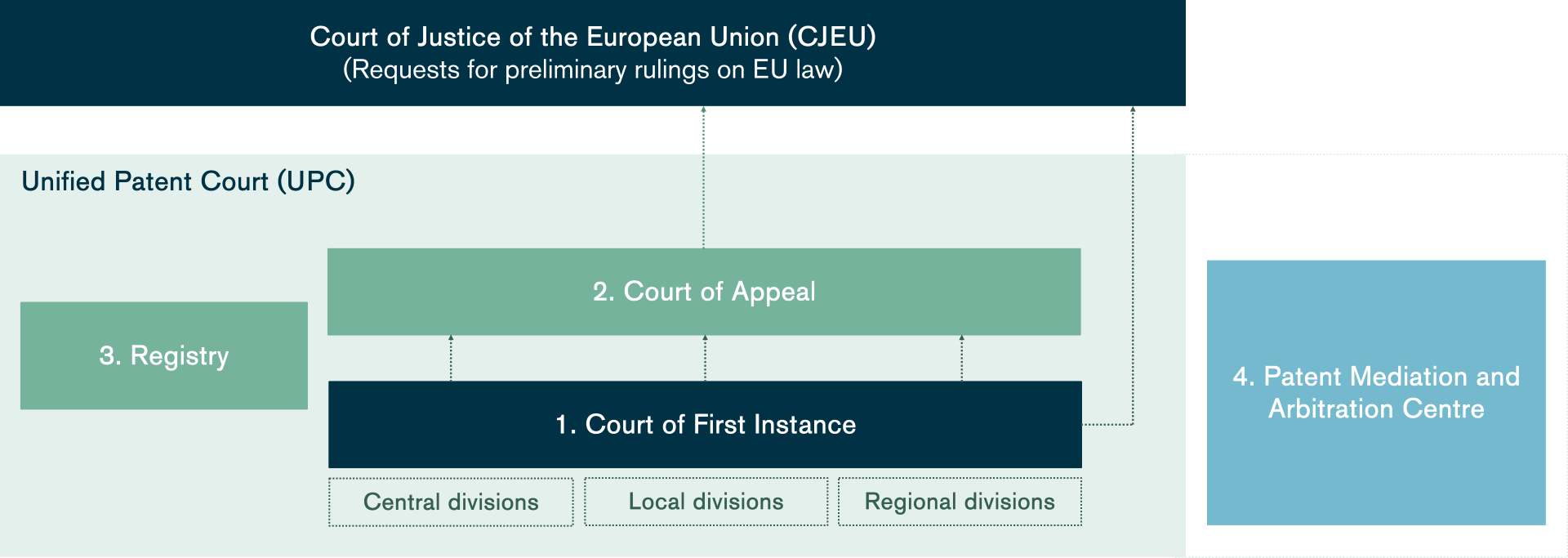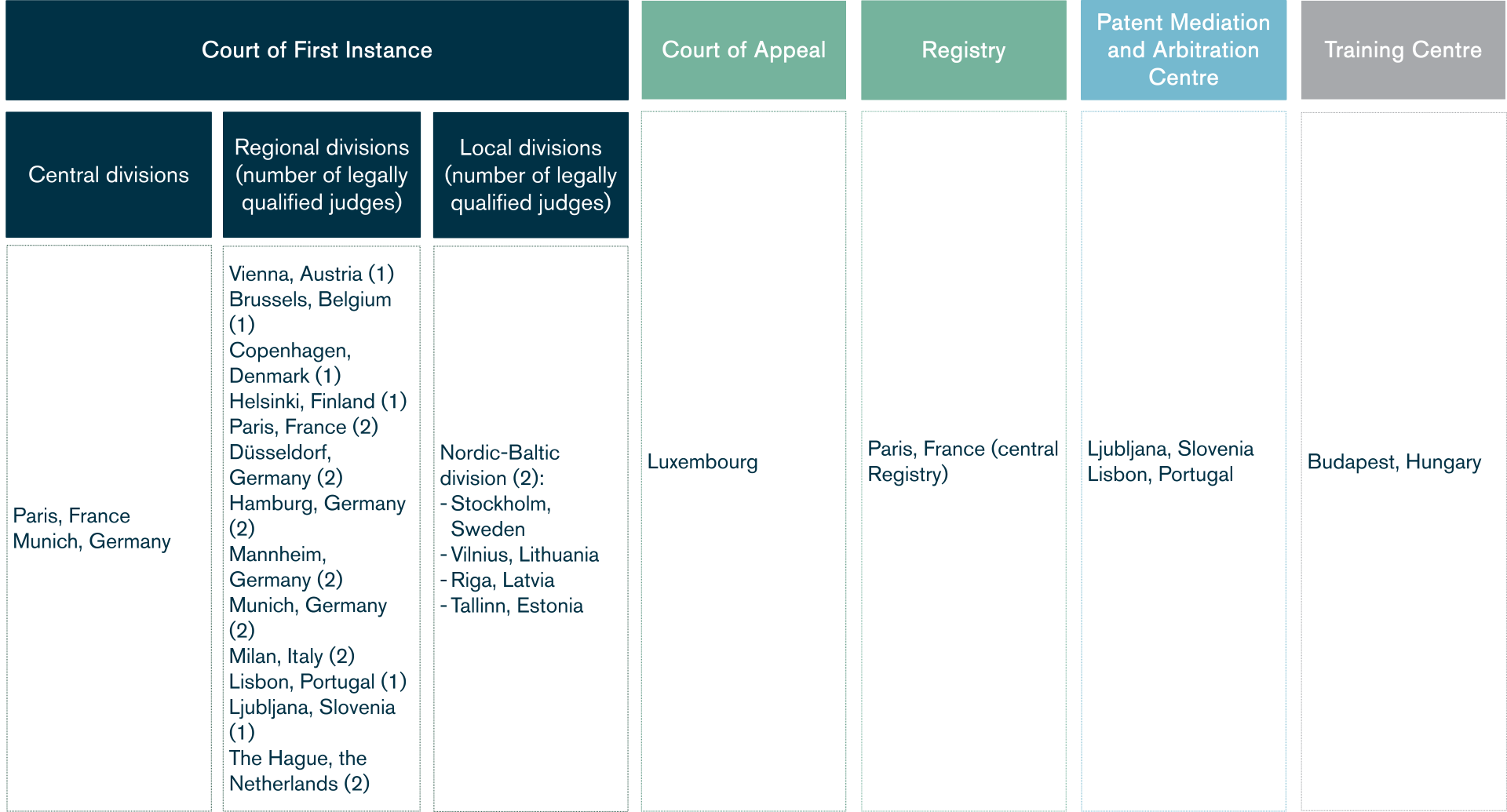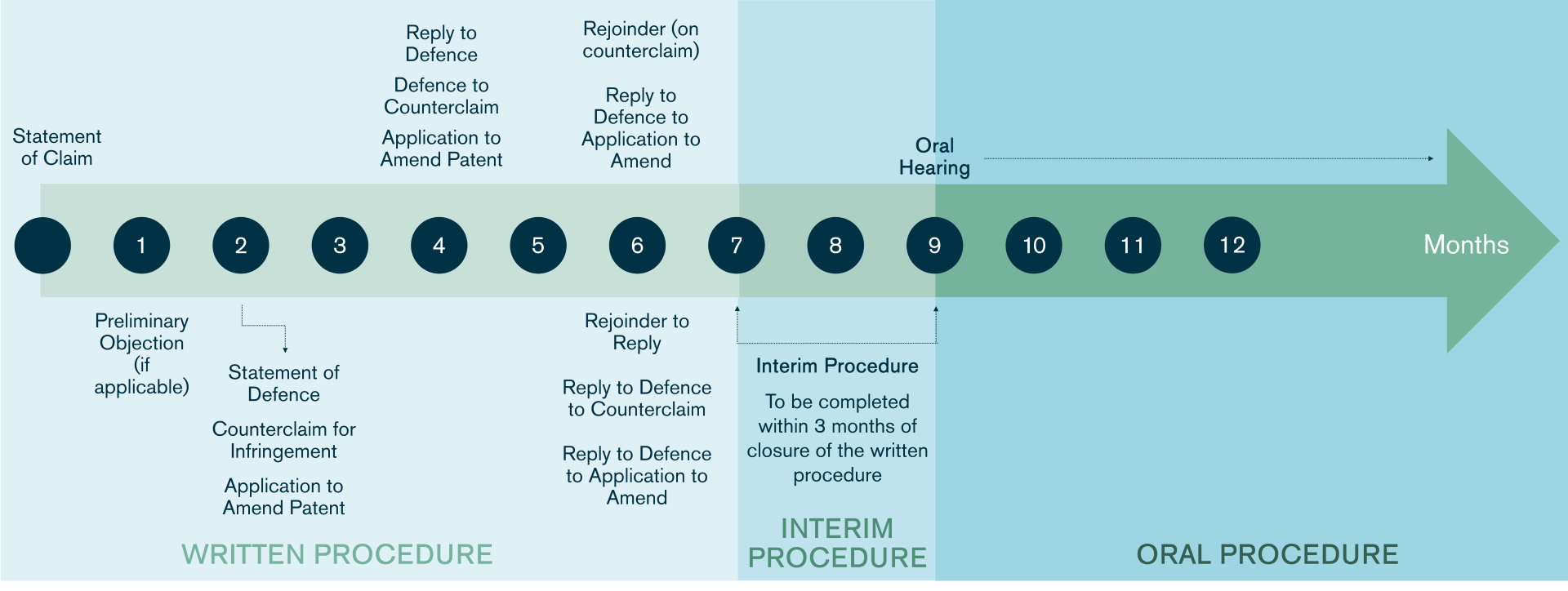UPC basics
Understand the fundamentals of the UPC with Osborne Clarke's quick guide to the essentials.
Overview
The Unified Patent Court (UPC) is an international court system for patent litigation in Europe that came into force on 1 June 2023. The UPC is a common court for EU Member States that are signatories of the European Patent Convention and which have ratified the UPC Agreement (UPCA). It is a single court, comprised of both first instance and appeal courts across multiple locations.
To date, the covers the 18 EU Member States that have ratified the UPCA. A further 6 EU Member States have signed the UPCA but not yet ratified it and are therefore are not currently participating in the UPC but may join it in the future. Other EU Member States could accede to the UPCA at some point in the future. Following Brexit, the UK is not a participant in the UPC.
The UPC has jurisdiction over disputes relating to the infringement and validity of unitary patents (UPs) and classic European patents (EPs). During the first 7 years (which may be extended up to a further 7 years), the UPC is in its transitional period. During the transitional period (ending in June 2030 at the earliest), both the UPC and national courts have jurisdiction over EPs. This means that, during the transition period, proceedings relating to EPs can be brought in either the UPC (provided that the patent has not been opted out of the UPC system) or in national courts.
During the transitional period, patentees can opt-out their EPs from the UPC, meaning the UPC will not have jurisdiction over them; exclusive jurisdiction of opted out EPs remains with the national courts.
Once transitional period had ended, the UPC will have exclusive jurisdiction over disputes relating to infringement and validity of UPs and classic EPs, and it will no longer be possible to opt out EPs from the UPC system.
Unitary Patents vs European Patents
A UP is a single patent right that covers all participating Member States of the UPC and is granted by the European Patent Office (EPO). Patentees are therefore able to obtain protection for their inventions across, at present, 18 EU countries with one patent that can be enforced centrally in the UPC. The patentee will pay a single annual renewal fee directly to the EPO to cover all countries participating in the UPC.
In contrast, EPs must be validated, maintained and, during the UPC's transitional period, can be enforced n either the UPC (if the patent is not opted out) or nationally in each country of designation.
Before a UP can be registered by the EPO, the applicant must initially obtain a European Patent. The EPO will assess the patentability requirements of the EP application. Once an EP application is granted, the patentee has the choice to either validate the EP in individual participating member states or request unitary effect (that is, opt for a UP).
UPC structure
The UPC is comprised of a Court of First Instance, a Court of Appeal, and a Registry. In addition, there will also be a Patent Mediation and Arbitration Centre and a Training Centre.
The Court of First Instance is made up of Local, Regional and Central Divisions located in different Member States (see UPC Locations below) whereas the Court of Appeal is situated in a single location – Luxembourg.
The Central Division of the UPC deals with: (1) actions for revocation; and (2) actions for non-infringement.
The Local and Regional Divisions deal with: (1) actions for infringement; (2) counterclaims for revocation; and (3) actions for provisional and protective measures.
There are, however, some nuances to the rules on competence of the Court of First Instance:
- If the defendant has no residence or place of business within the UPCA Contracting Member States, an action for infringement must be brought either (a) in the Local or Regional Division where the infringement occurred, or (b) in the Central Division.
- If the UPCA Contracting Member State concerned with the infringement has no Local or Regional Division, then the action for infringement must be brought in the Central Division.
- Although an action for non-infringement should be brought before the Central Division, if there is already an action for infringement between the same parties and same patent pending before a Local or Regional Division then those actions for non-infringement can only be brought before that same Local or Regional Division.
Further, if a revocation counterclaim is filed within ongoing infringement proceedings, the Local or Regional Division has three options within its case management powers:
- it can hear both actions;
- it can refer the revocation counterclaim to the Central Division (leading to bifurcation of the proceedings); or
- it can refer the entire case (infringement and revocation counterclaim) to the Central Division, with the agreement of the parties.
Both the Court of First Instance or the Court of Appeal may make requests for preliminary rulings on points of EU law to the Court of Justice of the European Union.
The Registry is based in Paris and is responsible for the administration of all proceedings, and the Patent Mediation and Arbitration Centre, which has yet to open, will have two locations and its own rules and procedures.

UPC locations

Judges
- In the Local and Regional Divisions of the Court of First Instance, the panel is made up of three legally qualified judges (and some times an additional technically qualified judge).
- The Local Divisions typically have three legally qualified judges, however the composition of the panel can vary depending the number of cases handled by the division per calendar year. Additionally, a technically qualified judge can be allocated to the panel upon request or if the court deems it necessary.
- In the Central Division, panels are usually made up of two legally qualified judges and one technically qualified judge in the field of technology concerned.
- In the Court of Appeal, panels are comprised of five judges: three are legally qualified and two are technically qualified in the field of technology concerned.

Language of proceedings
- The Central Division uses the language in which the patent was granted.
- The Nordic-Baltic Regional Division uses English.
- The rules relating to the Local Divisions are more complex. The Local Division generally uses the official language of the Contracting Member State where the Local Division is located. The Contracting Member States can also designate one or more of the official language of the EPO in addition or instead of their official language as the language of proceedings of the Local Division.
- There are also three sets of circumstances where the language of the patent can become the language of proceedings before a Local Division:
- the parties agree to use the language of the patent;
- with agreement of the parties, the panel of the Court of First Instance may decide to use the language of the patent; or
- at the request of one of the parties, and after hearing representations from the other parties and the panel, the President of the Court of First Instance may decide to use the language of the patent.
- The language of the proceedings at the Court of Appeal is the same language of the proceedings before the Court of First Instance.
Timings for first instance proceedings
The UPC Rules of Procedure set out a strict timeline for each stage of litigation. Actions in the UPC typically take between 12 and 15 months, with the UPC aiming to deliver its substantive decision on the merits within 12 months of the claim being commenced. UPC proceedings are divided into three parts: a written procedure, an interim procedure and an oral hearing.
The Court reviews the written submissions and one judge is appointed as a judge rapporteur (JR). The JR may order an interim conference to: (1) establish the main issues in a dispute, (2)clarify the positions of the parties, (3) make a schedule for further proceedings, (4) set a date for an oral hearing, and (5) determine the value of the dispute.
The written procedure period is typically seven to nine months. Oral hearings are normally scheduled to last only one day.
One aim of UPC proceedings is therefore to be faster than typical patent proceedings in the national courts.
Infringement first (Local Division) timeline

Revocation first (Central Division) timeline

Timings for appeals
The Court of Appeal is located in Luxembourg and hears all UPC appeals. Appeals can be brought by any party that has not been successful in whole or in part in its submissions.
The deadline for filing and responding to an appeal depends on the type of decision being appealed.
For appeals against final decisions of the Court of First Instance and decisions ending proceedings:

For appeals against orders to hold proceedings in the patent's language, orders to produce evidence, orders to preserve evidence and inspect premises, freezing orders, orders for provisional and protective measures and orders to communicate information regarding infringement products:

For appeals against orders other than those set out above (such as a costs decision or a procedural order):

Provisional measures
Provisional measures may be granted in favour of a patentee against an alleged infringer prior to commencement of an infringement action.
There are a variety of provisional measures available at the UPC. These include: (1) preliminary injunctions; (2) orders for seizure of products; (3) orders for preservation of evidence (saisie); (4) orders for inspection; and (5) freezing orders.
Who can bring proceedings?
In addition to patent holders, exclusive licensees are entitled to bring actions before the UPC, except where it is prohibited by the licence agreement. A non-exclusive licensee is not entitled to bring proceedings before the UPC unless it is expressly permitted to do so under the licence agreement. In both scenarios, the patent proprietor is entitled to join the action.
However, if infringement proceedings are brought by a licensee, and the patent proprietor is not participating in the proceedings, the validity of the patent cannot be challenged.
Opt-out

During the transitional period (June 2023 to June 2030 or June 2037 if the transitional period is extended),an EP can be permanently opted out of the UPC's jurisdiction, provided that it has not already been litigated before the UPC. Opting an EP out of the UPC gives national courts exclusive jurisdiction, as was the case before the UPC started operations.
Applications to opt-out must be made no later than one month before the end of the transitional period that will end on 1 June 2030 (or 1 June 2037 if the period is extended).
Conventional EPs in a "bundle" must be opted out together, and once opted out, an EP will not be in the UPC's jurisdiction. The opt-out of an EP automatically opts out any attached SPCs. SPCs granted on the basis of a UP cannot be opted out.
An opt-out can be withdrawn at any time, provided that an action has not already been brought before the national court. Withdrawing an opt-out can only be done once.
National patents will continue to be available from a country’s granting office and can be litigated nationally as at present.
Costs
Unitary Patent fees
No specific fees will need to be paid to the EPO for the filing and examination of the request for unitary effect. A single translation of the patent application (into English, or another official EU language) will need to be filed with the EPO during the transitional period, and therefore the corresponding translation costs will be lower than for obtaining a EP.
In addition, one objective of the UP is to reduce the renewal costs, with annual fees corresponding to the combined renewal fees of the four countries where EPs are most validated. The fees must be paid at the EPO and increase in proportion to the number of years of validity (the first year being fixed at €35 and the 20th year at €4,855).
Compared to EPs, the renewal fees are lower if a large territorial scope is sought (usually five or more designated countries) but remain higher where the protection sought is limited to only a few EP countries.
The impact of Brexit will also need to be taken into account, as, for the UK, a separate EP will be necessary.
Due to the unitary effect, it is not possible to limit the renewal costs of a UP by withdrawing from a particular Contracting Member State (unlike an EP which can be abandoned on a country-by-country basis).
Proceedings costs
UPC court fees, whether for infringement or revocation proceedings, are comprised of a fixed fee and a value-based fee for the actions exceeding a value of €500,000.
The fixed fee for infringement claims, counterclaims for infringement, actions for declarations of non-infringement and actions for compensation for licence of right is set at €11,000 and an additional fixed fee of €3,000 is payable for applications to determine damages. For independent revocation claims, the fixed court fee is €20,000.
In terms of recoverability of the litigation fees, the UPC Rules of Procedure provide that the unsuccessful party must bear the costs of the proceedings.
Court fees are recoverable in full, as are other costs (other than the cost of legal representation, such as for technical expert advice), which are recoverable provided they are reasonable and proportionate.
As for the costs of legal representation, the successful party will be entitled to recover them provided they are reasonable and proportionate and within the limits of the recoverable costs ceiling.
Based on the value of the dispute, these costs range from €38,000 for cases valued up to €250,000 to €2million in cases where the value at stake exceeds €50 million. These limits maybe raised in exceptional circumstances to an absolute maximum of €5 million for particularly complex cases.